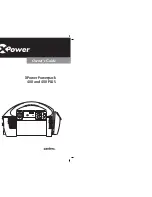
Page 81
EA Elektro-Automatik GmbH
Helmholtzstr. 31-37 • 41747 Viersen
Germany
Fon: +49 2162 / 3785-0
Fax: +49 2162 / 16230
www.elektroautomatik.de
PSI 9000 15U/24U Series
3.11.4.2
Connecting devices to a 2QO
There are several ways to connect source(s) and sink(s) to make a 2QO, but for this power supply series this
configuration is recommend:
Share-Bus
E.U.T
E-LOAD
PSU
1 e-load and 1 power supply, plus 1 test object (E.U.T).
This is the most common configuration for 2QO. The nominal
values for U,I and P of the two devices should match, such
as EL 9080-1530 B 15U and PSI 9080-1530 15U. The sys
-
tem is controlled by the power supply. The load system will
be configured as slave regarding the Share bus connection.
3.11.4.3
Settings on the devices
Regarding the general 2QO operation no extra setup is required on the power supply cabinet. Given that multiple
electronic loads are used as sink, which also form a master-slave system, there is a parameter to set for the load
system’s master unit. Set the checkmark on “PSI/EL system” in page “Master-slave mode” of the General Settings
in MENU. This will cause the load system to act as slave on the Share bus.
For safety of the connected E.U.T / D.U.T and to prevent damage, we recommend to adjust supervision thresholds
like OVP, OCP or OPP on all units to the desired levels, which will then switch off the DC output resp. the DC input
in case of excess.
3.11.4.4
Restrictions
After the electronic load system has been connected via the Sharebus with the power supply system as controlling
device, the load cannot limit their input voltage anymore to what you adjust as “U set” on the device. The correct
voltage level comes from the source, which controls the sink’s voltage via Share bus.
3.11.4.5
Application example
Charging and discharging a set of 8 batteries with 24 V/300 Ah, using configuration A from above.
•
Power supply PSI 9080-1020 15U with: I
Set
= 240 A (charging current, 1/10 of Ah), P
Set
= 30 kW
•
Electronic load EL 9080-1020 B 15U set to: I
Set
= discharging current for the battery (eg. 500 A), P
Set
= 14.4 kW,
plus probably UVD = 20 V with event type “Alarm” to stop discharging at a certain low voltage threshold
•
Assumption: battery has a voltage of 26 V at test start
•
DC input(s) and DC output(s) of all units switched off
In this combination of devices it is recommended to always switch on the DC output of the
source first and then the DC input of the sink.
1. Discharge of the battery to 24 V
Setup: Voltage on the power supply set to 24 V, DC output of power supply and DC input of load activated
Reaction: the e-load will load the battery with a maximum current of 100 A in order to discharge it to 24 V. The
power supply delivers no current at this moment, because the battery voltage is still higher than what is adjusted on
the power supply. The load will gradually reduce the input current in order to maintain the battery voltage at 24 V.
Once the battery voltage has reached 24 V with a discharge current of approx. 0 A, the voltage will be maintained
at this level by charging from the power supply.
The power supply determines the voltage setting of the load via the Share bus. In order to avoid
deep discharge of the battery due to accidentally setting the voltage on the power to a very low
value, it is recommended to configure the undervoltage detection feature (UVD) of the load, so
it will switch off the DC input when reaching minimum allowed discharge voltage. The settings
of the load, as given via the Share bus, can’t be read from the load’s display.
2. Charging the battery to 27 V
Setup: Voltage on the power supply set to 27 V
Reaction: the power supply will charge the battery with a maximum current of 40 A, which will gradually reduce
with increasing voltage as a reaction to the changing internal resistance of the battery. The load absorbs no current
at this charging phase, because it is controlled via the Share bus and set to a certain voltage, which is still higher
than the actual battery voltage and the actual output voltage of the power supply. When reaching 27 V, the power
supply will deliver only the current needed to maintain battery voltage.








































